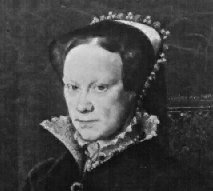



ary I, called Mary Tudor (1516-58), queen of England (1553-58).
Mary was born in London on February 18, 1516, the daughter of Henry VIII of England, by his first wife, Catherine of Aragón. On the death of her half brother, Edward VI, on July 6, 1553, she became the legal heir to the throne. Lord High Chamberlain John Dudley, duke of Northumberland, however, favored the succession of his daughter-in-law, Lady Jane Grey. He proclaimed her queen on July 10, but the country supported Mary.
Mary began her reign by sweeping away the religious innovations of her father. Mass was restored without opposition and the authority of the pope reestablished, but Parliament refused to restore the church lands seized under Henry VIII. Mary, however, restored the property that the Crown still possessed. Even more disastrous was her marriage in 1554 to Philip II, king of Spain. The engagement was greeted in England by a formidable rebellion under the leadership of Sir Thomas Wyatt to depose Mary and put her half sister, Elizabeth, later Elizabeth I, on the throne. Philip was an uncompromising Roman Catholic and unpopular in England. At his order, Mary joined in a war against France, with the result that Calais, the last remnant of the English conquests won during the Hundred Years' War with France, was lost in 1558.
 The ferocity with which Mary's personal
character has been assailed by certain writers must be ascribed
to religious zeal. She was called Bloody Mary because of a large
number of religious persecutions that took place during her reign;
almost 300 people were condemned to death as a result of trials
for heresy. Mary died in London on November 17, 1558, and was
succeeded by Elizabeth I. [Microsoft Encarta 98 Encyclopedia]
The ferocity with which Mary's personal
character has been assailed by certain writers must be ascribed
to religious zeal. She was called Bloody Mary because of a large
number of religious persecutions that took place during her reign;
almost 300 people were condemned to death as a result of trials
for heresy. Mary died in London on November 17, 1558, and was
succeeded by Elizabeth I. [Microsoft Encarta 98 Encyclopedia]